What Firefighters Can Teach Architects About Radiant Heat
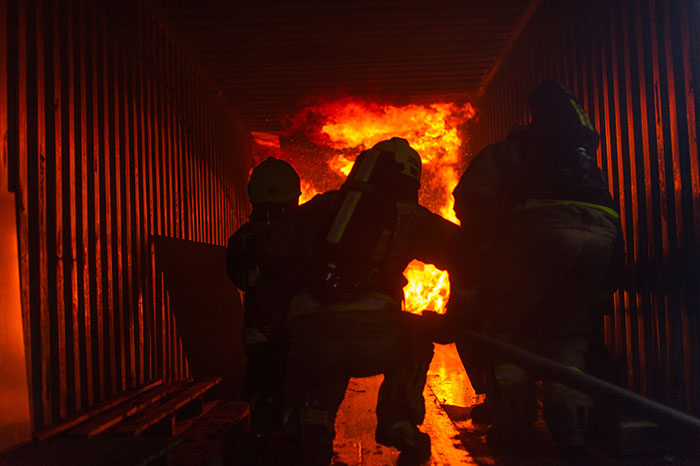
What Architects Can Learn From Firefighters About Radiant Heat
It takes a tremendous amount of courage to be firefighter. While most people will instinctively locate the nearest exit to escape a burning building, firefighters run towards it. In any firefighting operation, the first and foremost objective is to rescue building occupants. After rescue, or simultaneously with rescue, comes fire confinement, where firefighters use water or another extinguishing agent to confine the fire in one area. Stopping the fire’s forward progress must be done first before it can be extinguished.
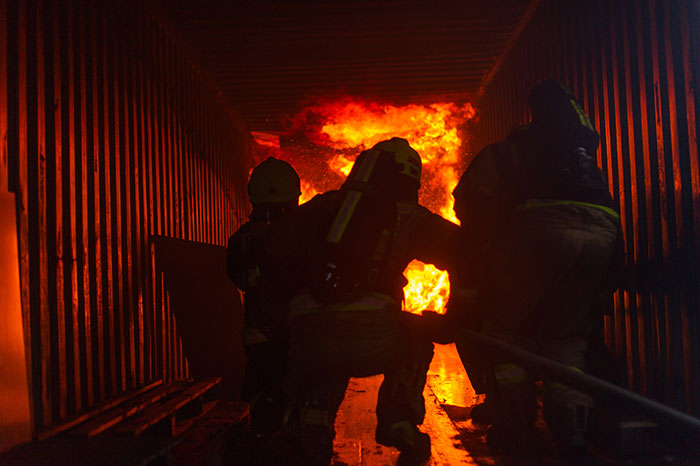 |
| Firefighters run towards a burning building to rescue building occupants and contain/extinguish the fire. |
In carrying out both objectives, radiant heat is a major concern because not only does it prevent firefighters from getting to the building that is on fire, but it also contributes to the spread of fire. Structures near a fire building (exterior exposures) and parts of the building not yet involved (interior exposures) must be protected to minimize danger to their occupants as well as to contain the fire.
Radiant heat is also a major concern for architects because the buildings they design are occupied by people. In the event of a fire, a building’s design and the materials chosen to build it can directly impact the occupants’ ability to safely exit the building. The building’s design and materials can also impact how effectively firefighters can rescue building occupants and confine and eventually extinguish a fire. This is why it is important for architects to understand radiant heat from the firefighter’s perspective.
What is radiant heat?
Smoke and flames, the visual components of a fire, draw the most attention. However, there is also a third and invisible component called radiant heat that is just as dangerous to building occupants. If you’ve ever stood in front of a fire to keep yourself warm, then you’ve experienced radiant heat first hand. In small doses, it can be comforting and even nice. However, in large doses, such as a heat generated by a building fire, it can be extremely dangerous, and even fatal.
Radiant heat is invisible, extremely intense, electromagnetic waves that travel at the speed of light with little or no resistance from air. When these waves strike an object they are absorbed and their energy is converted to heat. If the object is a combustible material, such as paper, fabric, or wood, a fire will start when the material’s ignition temperature is reached.
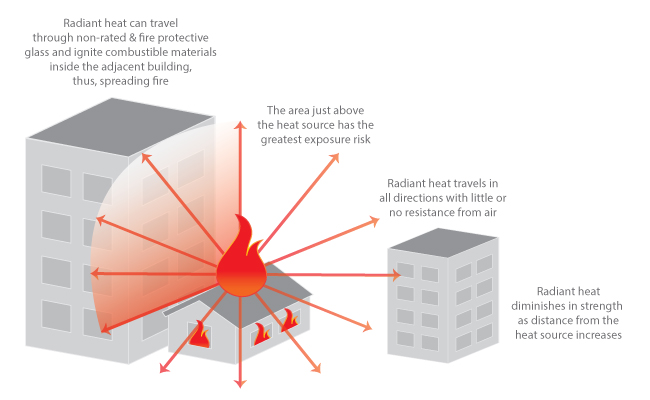 |
| Radiant heat travels in straight lines, in all directions. |
How radiant heat impacts rescue
Radiant heat is extremely dangerous to building occupants since it can quickly reach a level that causes unbearable human pain, followed rapidly by second degree burns. The pain and burns sustained by building occupants from the uncontrolled passage of heat can be so intense that they are unable to exit the building safely. This is why the building code requires horizontal exits (e.g. corridors) and vertical exits (e.g. stairwells) to be protected from smoke, flames and radiant heat for 1 or 2 hours. This gives building occupants a path of safe egress even before the fire department arrives at the scene. It can also provide a safe haven where they can await rescue, which can be the case in hospitals, urgent care, long-term care and other healthcare facilities where immobile patients make evacuation difficult or impossible.
To ensure that building materials used in these exits can stop smoke, flames and limit radiant heat transmission, it must be tested and certified to meet ASTM E-119, the fire resistive wall criteria. Gypsum, masonry and sheet rock are typically used, but when vision and transparency are desired, fire resistive glass that also meets ASTM E-119 can be used. It functions as a ‘transparent wall’ and can be used up to the maximum size tested.
In some 1 hour corridors, fire protective glass can be used in 20 minute door vision panels and 45 minute openings. But because fire protective glass does not protect against radiant heat or meet the ASTM E-119 criteria, the openings are limited to 25% of the wall area. To exceed 25%, fire resistive glazing must be used.
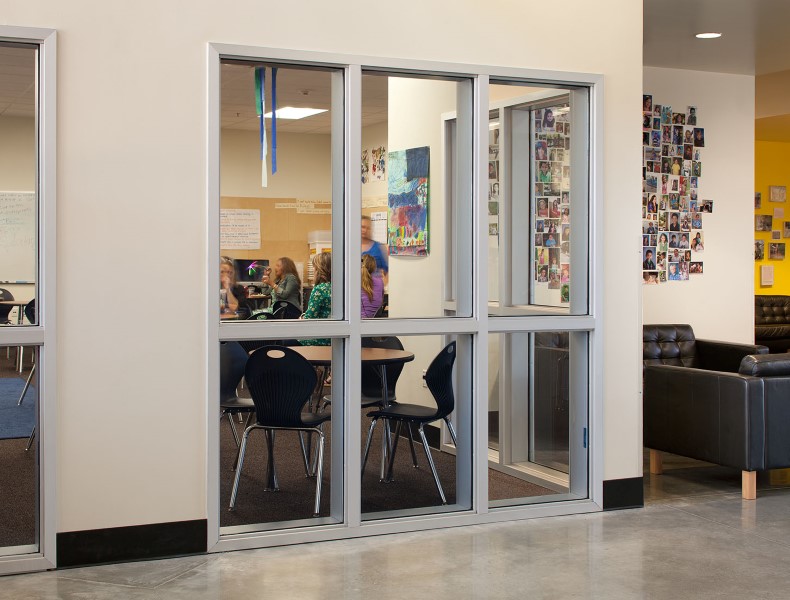 |
| The code allows 45-minute openings in 1 hour corridor walls, as long as it is limited to 25% of the wall area. Even if ASTM E-119 is not required by code in this application, architects can still specify a clear, 45-minute product that is proven to limit radiant heat by meeting the ASTM E-119 requirement. These products do not have any amber tints, provide additional radiant heat and sound attenuation benefits, made in the USA and cost much less than ceramics used in the same application. Project: High Tech High. Architect: Studio E. Glazier: Vision Systems Inc. Products: SuperLite II-XL 45 in GPX Builders Series Framing. |
Fire protective glass is not allowed at all in 1 and 2 hour stairwells and fire barrier walls, except for the 100 sq. in. vision panel in the 60 or 90 minute temperature rise doors. Again, to exceed 100 sq. in. in the door vision panel, fire resistive glass must be used. For a complete reference on where fire protective and fire resistive glazing are allowed in the code, refer to the Chapter 7 Tables in the 2012 and 2015 IBC.
 |
| To meet code and provide transparency and natural light, fire resistive glass and frames were used in this 2-hour stairwell application. Project: University of Utah David Eccles School of Buisiness. Architect: MHTN. Glazier: Mollerup Glass. Products: SuperLite II-XL 120 (wall) and SuperLite II-XL 90 (door) in GPX Architectural Series Framing. |
How radiant heat impacts fire confinement
As mentioned earlier, the firefighters’ secondary objective after rescue is fire confinement. Firefighters cannot effectively extinguish the fire if they cannot control how far it spreads – including to surrounding buildings due to intense radiant heat. As one firefighting training guide describes it:
Two of the most effective ways to prevent radiant heat transmission from one building to the next is by providing significant distance between the two structures, or to have unpierced fire walls. However, that is not always the case. In densely populated areas such as New York City, San Francisco, Chicago and Boston (to name a few), buildings are built close together, either a few feet or right at the property line. And while the building code does allow windows or openings in exterior fire walls, there are restrictions its use because as stated above, radiant heat will pass through the glass and ignite the combustible materials behind it. Table 705.8 in the 2012 and 2015 IBC lay out the percentage of protected and unprotected openings and size limits allowed in exterior walls. Because fire protective glass does not protect against radiant heat, it is either limited in size or prohibited altogether, depending on the fire separation distance.
However, these limitations do not apply to fire resistive glazing that meets ASTM E-119 because these products are considered in the code as ‘transparent walls’ and not openings or windows. If an exterior fire wall incorporates fire resistive glazing for vision or transparency, it is still considered as an unpierced fire wall. And as mentioned earlier, having unpierced fire walls is one of the best ways to prevent radiant heat from spreading from one building to the next – especially when there is very little distance between them. This is very important because again, only when a fire is confined can firefighters effectively extinguish it.
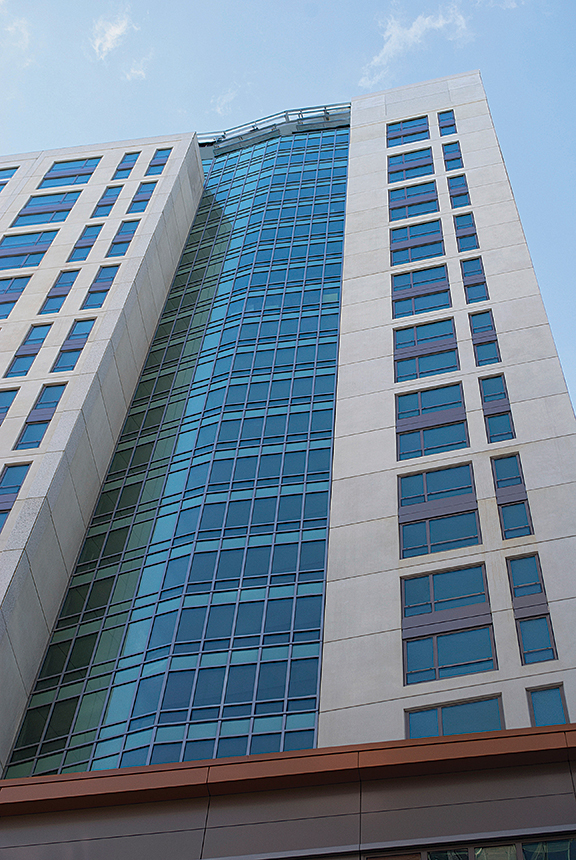 |
| The west-facing elevation was in close proximity to the property line, so part of the curtain wall had to be fire rated. To maintain views and preserve the design intent, the architects specified ASTM E-119 rated, fire resistive glass and framing that matched the aesthetic of the adjacent non-rated system. The fire resistive curtain wall also met dynamic curtain wall testing, to ensure that it is air and water tight. Project: The Kengsington. Architect: TAT. Glazier: Cheviot. Products: SuperLite II-XL 60 insulated with Solarban 70XL in GPX Curtain Wall Framing |
Building materials are the first line of defense
As architects continue to design buildings, some perspective can be gained from learning about the devastating effects of radiant heat on people and property from the brave firefighters who have experienced it first-hand. In a way, the building materials that architects specify are the first line of defense when it comes to limiting radiant heat, and offer significant assistant to firefighters in their rescue and fire confinement objectives. Advanced life safety building products like fire resistive glazing systems that meet the ASTM E-119 criteria enable architects to combine maximum fire protection with vision, transparency and all the aesthetic benefits that glass has to offer.
More to come: forcible entry through different types of glazing
In certain situations, firefighters find it necessary to break windows for ventilation or rescue. In our next blog, we explore how different types of glazing materials can either help or hinder rescue operations. Stay tuned!
REFERENCES
1 “The Firefighter’s Handbook: Essentials of Firefighting and Emergency Response (2nd Edition),” page 609. National Fire Academy Alumni Association.
2 “Engine Company Fireground Operations (2nd Edition),” page 97. Harold Richman.
3 “Engine Company Fireground Operations (2nd Edition),” pages 100-101. Harold Richman.